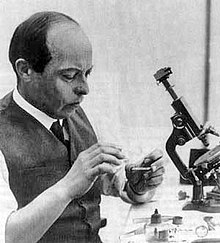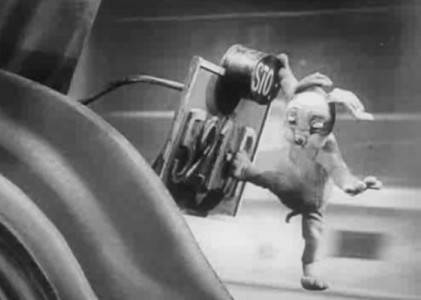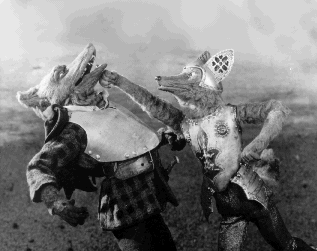
Figure 1. Ladislaw Starewicz
Starewicz animation shows exceptional attention to detail particularly with facial animation. One would not expect such a range of character motion from seemingly static custom made dolls & animals. It is only until one sits back and considers the dedication of Starewicz providing generations with a unique brand of stop motion animation.
Best known for:
•Stop Motion animation using physical animals & insects
•Animated Short “La Voix du rossignol” (The Voice of the Nightingale)
•Animated Short “Fétiche Mascotte” (The Mascot)

Figure 2. Wired Beetles
Ladislaw Starewicz started his life with a fascination of insects & animals it is this which lead him into his particular field of animation. His desire was to push these creatures into films considering them viable cast members to his animated pursuits. For what young child was not interested in bugs at a young age, his vision was not limited for soon he would attempt to recreate the visual experiences of his bug sized friends & beyond. Rubberneck of Millennial Mavericks observes:
“An early obsession with entomology led to a desire to film his subjects. Unfortunately, the heat from his studio lights caused the poor creatures to expire. Starewicz's solution to this problem was to construct detailed models of insects which he could then manipulate at will, a process which fired his imagination”. (Rubberneck: 1997)Ladislaw’s method was bold and probably took a great amount of trial & error; one could imagine it being particularly difficult with living insects through their need to degrade after time. Still one would have to respect how this would lead Ladislaw down the path of models that have a range of animation. It is still particularly amazing when one considers his animated beetle shorts, replacing their legs with wires to create beetle sized puppets. From this plateau one would have to consider Ladislaw’s ability to create a controllable skeleton from the inanimate small to large.

Figure 3. The Mascot
Let us reflect on the inner message showcased in Starewicz work, more importantly trying to give life to the inanimate. One could argue that his pursuits were very much like that of Winsor McCay and many animators after him, just wanting to see their characters come to life and interact with them. With that being said it is fair to say that Starewicz surveyed the creatures of his work to note how they moved & how that movement could be implied on a character gesture. As much can be found in his works particularly “The Mascot” which truly creates a lovable vibe from what some could consider being an uncanny affair. Adrian Danks of senses of cinema observes:
“These toy or doll characters are of course given a degree of human agency. They act in a fashion that is in keeping with the stereotypes imparted on them by the humans. Thus, the central character of the film is Duffy, an expressive, but somewhat worn dog-toy who is brought “to life” by the tear of a child’s (its owner) mother.” (Danks: 2004)The range of motion expressed in Starewicz “The Mascot” is amazing; the characters are cute providing child like comedy throughout. One would even have to respect some of the characters abilities to do miniature motion such as blinking. The story itself is sad but portrays the world as a surreal large plateau with evil hidden behind dirty corners. The opening scene is quite possibly the most touching with a single tear animating this otherwise lifeless toy. The vision of “The Mascot” is quite vivid but it pulls at the heart strings & has a comedic charm that would otherwise feel too forced. The stereotypes aside Starewicz truly had an eye for motion & gesture.

Figure 4. Tale of the Fox
Starewicz’s work was & still is impressive, leading on to inspire many in completely different ways. It is quite bizarre to think back to the origin of a trade, mostly consisting of experimentation & the curiosity of a chosen few. One could argue that Starewicz did not explore a trade or an art form; he explored a hobby (his fascination with insects), something he truly loved to bring entertainment to the masses & provide a tool kit that would be used for generations to come. From moving insects we were given moving toys contrasted with on screen human beings subtly showing how close our reality can come to fiction. M. Faust of Art Voice observes:
“In particular, Starewicz’s 1993 short “The Mascot” plays like a blueprint for the style of Tim Burton productions like “The Nightmare Before Christmas”, with its large cast of bizarre dolls & puppets brought to life by painstaking stop-motion work. It’s impressive even by today’s standards.” (Faust: 2010)Starewicz wonders continue to inspire today generation after generation producing memorable animation and narrative gems such as Pixar’s “Toy Story”. It is testament to ones resolve when one considers the work required to convey the range of motion in Starewicz work. The dolls in each short are cute not particularly scary (unless required – the devil in “The Mascot”). The demeanours are expressive & convey their stereotype all the way from the adolescent puppy to the enraged adult gangster. One could even attribute this range to other contemporary productions such as Tim Burton’s “The Nightmare before Christmas”, this truly shows how Starewicz work has secured the influence of the current generation.
List of Illustrations
Figure 1. Ladislaw Starewicz. (com) [Online image]. At: http://upload.wikimedia.org/wikipedia/commons/thumb/7/75/Starevich_1.jpg/220px-Starevich_1.jpg (Accessed on: 21/03/12)
Figure 2. Wired Beetles. (com) [Online image]. At: http://i1190.photobucket.com/albums/z455/andriana18/ladislaw-starewicz2.jpg
(Accessed on: 21/03/12)
Figure 3. The Mascot. (com) [Online image]. At: http://www.movingimagesource.us/images/articles/Mascota01_2-20090717-120839-medium.jpg
(Accessed on: 21/03/12)
Figure 4. Tale of the Fox. (com) [Online image]. At:
http://www.awn.com/heaven_and_hell/STARE/IMAGES/roman.gif (Accessed on: 21/03/12)
Bibliography
Rubberneck. (1997) Animal Magnetism: The Animation of Ladislaw Starewicz. At: http://www.users.globalnet.co.uk/~rneckmag/starewic.html
(Accessed on: 21/03/12)
Danks, Adrian. (2004) Ladislaw Starewicz and The Mascot. At:
http://www.sensesofcinema.com/2004/cteq/starewicz_mascot/ (Accessed on: 21/03/12)
Faust,M. (2010) The Films of Ladislaw Starewicz. At:
http://artvoice.com/issues/v9n7/film_reviews/ladislaw_starewicz (Accessed on: 21/03/12)

No comments:
Post a Comment